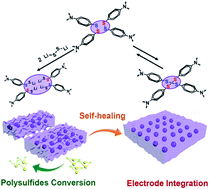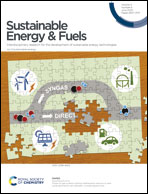Improving the capacity and cycling-stability of Lithium–sulfur batteries using self-healing binders containing dynamic disulfide bonds†
Abstract
Lithium–sulfur batteries, which can be applied for portable electronic devices with longer endurance, have received tremendous attention because of their high theoretical capacity and high energy density. However, both electrode volume variation and serious shuttling effects during the charge/discharge process limit the promotion of lithium–sulfur batteries. In this work, a novel self-healing poly(dimethylsiloxane) polymer with dynamic disulfide bonds (2S-PDMS) was designed as a binder for sulfur electrodes. The disulfide bonds in 2S-PDMS molecules can reversibly break and form, facilitating the conversion of polysulfides, as evidenced from both experimental and calculated results. In addition, 2S-PDMS binders with a remarkable self-healing ability and flexibility can keep the sulfur cathode integrated without cracks or damage. Consequently, the 2S-PDMS-based cathode exhibits both high capacity and excellent cycling stability, showing a specific capacity of 545.7 mA h g−1 at 2.0C after 400 cycles (79.6% capacity retention). Moreover, soft-packed Li–S batteries with a high sulfur loading of 6.6 mg cm−2 deliver a high areal capacity of 4.54 mA h cm−2 after 50 cycles, which verifies the good flexibility and stability of the 2S-PDMS-based cathode.



 Please wait while we load your content...
Please wait while we load your content...